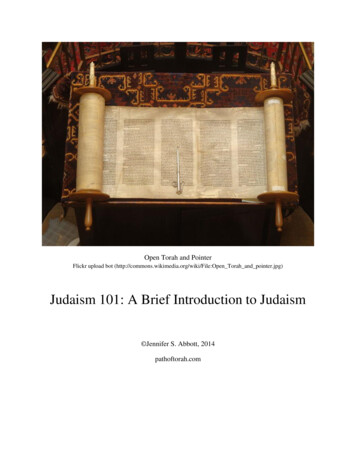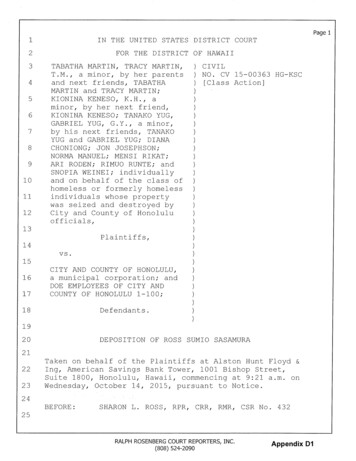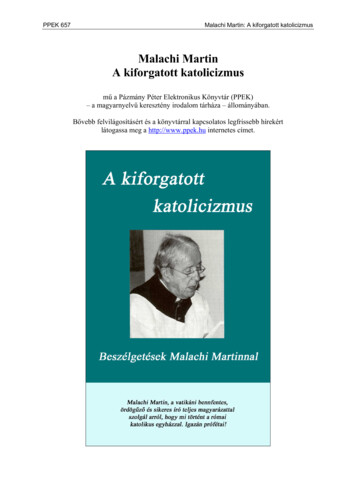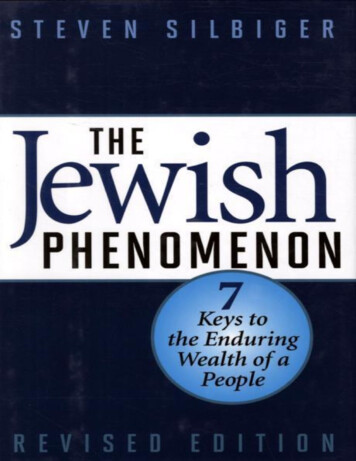![[Goodman Martin] Judaism In The Roman World](/img/16/goodman-2007.jpg)
Transcription
Judaism in the Roman WorldCollected EssaysbyMartin GoodmanLEIDEN BOSTON2007
CHAPTER NINETEENJEWS AND JUDAISM IN THE MEDITERRANEANDIASPORA IN THE LATE-ROMAN PERIOD:THE LIMITATIONS OF EVIDENCEModern interpretations of the nature of Judaism in the Mediterraneandiaspora in the late-Roman period have been based mainly on theevaluation of archeological and epigraphic data. Such interpretations are mostly quite possible, but all involve eisegesis and (oftenundeclared) assumptions which are here systematically questioned.In particular, evidence customarily used to reconstruct a picture ofa liberal diaspora Judaism is scrutinized to see how much of it infact may have been produced by pagan polytheists who revered theJewish God. The evidence from Sardis is treated as a test case. Inthe final section a decrease in the variety within Judaism, and adecline in the numbers of pagan polytheists worshipping the JewishGod, are postulated for the period after 388 CE, when Romanemperors began to attack pagan shrines and to give state supportto the Jewish patriarchs.No one doubts that the population of the Mediterranean core ofthe Roman Empire at its height, from the first to the fifth centuryCE, contained a large proportion of Jews. Estimates of their numbervary quite widely,1 but that they constituted a group of sufficientsize to exercise considerable influence over Mediterranean society isgenerally agreed. What elicits much less agreement is the nature oftheir Judaism in the centuries which followed the destruction of theTemple in Jerusalem by the Romans in 70 CE.It will be evident from the title of this article that I believe it tobe helpful to study diaspora Judaism in this period separately fromthe religion of Jews in the land of Israel. This separation is desirabledespite the similar geographical and economic constraints on Jewishcommunities in all parts of the Mediterranean world, despite theCf. S.W. Baron, A Social and Religious History of the Jews, 2nd ed. (New York:Columbia University Press, 1952) vol. 1, 167–171, 370–372.1
234CHAPTER NINETEENcomparative ease of transport between such communities in the firstcentury CE because of the pax Romana and extensive inter-regionaltrade,2 and despite the common obeisance of all MediterraneanJews to the same Torah by which God bound Israel in covenanton Mount Sinai.3 Despite all this, the special role of Israel as a holyland necessarily influenced religious behaviour, and may well havecaused the religious outlook of Jews who lived there to be differentfrom that of diaspora Jews. In Jews’ religious geography, the centreof the world, the core of purity, lay in the Holy of Holies in theTemple in Jerusalem. The rest of the world was relegated to spheresof decreasing purity in a series of concentric circles, from the Templeto the city of Jerusalem to the boundaries of the land of Israel andthence to the diaspora.4The probability that diaspora Judaism in the Mediterranean worlddiffered from that of Jews in the homeland is strengthened by the factthat most evidence about Judaism in this period happens to deriveeither from the land of Israel or from the Jews of Mesopotamiawho, since they lived outside the Roman empire, had little contactwith the western diaspora. This same fact means that disagreementabout the nature of Judaism in the Mediterranean diaspora beginsfrom uncertainty about how much, if at all, to rely on the rabbinicevidence from late antiquity: some scholars assume that all Jews followed rabbinic norms until proved otherwise, others that none diduntil shown to have done so.5Both views are possible, but I should confess that my own preferenceis for skepticism about the applicability of rabbinic evidence outsidethe immediate circles for which it was composed.6 The preservation2Cf. K. Hopkins, “Taxes and trade in the Roman Empire (200 BC–AD 400),”Journal of Roman Studies 70 (1980) 101–125.3E.P. Sanders, Paul and Palestinian Judaism: a Comparison of Patterns of Religion,(London: SCM, 1977); Idem, Judaism: Practice and Belief: 63 BCE–66 CE (London:SCM, 1992).4Cf. M. Goodman, The Ruling Class of Judaea: The Origins of the Jewish Revolt AgainstRome, AD 66–70 (Cambridge: Cambridge University Press, 1987) 106.5Contrast the assumption by Schiffman, Who was a Jew? (New York: Ktav, 1985),that rabbinic discussions in the land of Israel were capable of bringing about thesplit between Judaism and Christianity to the assertion by Kraabel, “Impact ofthe Discovery of the Sardis Synagogue” in Sardis from Prehistoric to Roman Times, ed.G.M.A. Hanfmann (Cambridge, MA: Harvard University Press, 1983) 178–193,that rabbis had no influence at all in Asia Minor.6Cf. M. Goodman, State and Society in Roman Galilee, AD 132–212 (Totowa, N.J.:Rowman and Allanheld, 1983) 5–14.
JEWS AND JUDAISM IN THE MEDITERRANEAN DIASPORA235of so much rabbinic literature by Jews of later generations encourages the impression that the rabbis predominated in Jewish societyof the time when the literature was composed, but it is in principlenot justified to take the survival of material as evidence of its original importance. Rabbinic texts from late antiquity are extant onlybecause their contents interested enough Jews through the medievalto the early modern period for them to be continuously copiedand eventually printed. In contrast, Jewish texts written in Greekwere totally ignored by the later rabbinic tradition, which operatedprimarily in Hebrew and Aramaic. Thus it is entirely possible thatdiaspora Jews composed just as many literary works in Greek after 70CE as before that date, but that all such literature has disappearedsimply because the religious traditions which eventually triumphedhad no interest in their preservation: on the one hand, the rabbis,who only preserved writing in Semitic languages, and on the other,the Christian Church, which treasured and appropriated Jewish textswritten in Greek before c. 100 CE but which treated later Jewishcompositions as the product of an alien faith.7The possibility of a misleading bias in the preservation of theevidence is not the only factor which complicates the use of rabbinictexts. The rabbis took it for granted that their view of the worldwas normative for all Israel, but such a view can quite well persistregardless of reality. It is entirely possible, even if in the final analysisunprovable, that, even within the communities in which they operated, the rabbis were sometimes met with indifference.8 If rabbinicliterature can be used only with care to reconstruct the religiousoutlook of Jews in the land of Israel where it was composed, itwill be all the more difficult to use it to understand the Judaism ofAlexandria, Antioch, Sardis, Rome.For some scholars the non-rabbinic nature of (some) diasporaJudaism in late antiquity is simply taken for granted,9 and over thepast few decades many attempts have been made to construct a picture of an alternative Judaism based on different kinds of evidence.107Cf. G. Vermes and M. Goodman, “La literature juive intertestamentaire àla lumière d’un siècle de recherches et de découvertes” in Etudes sur le JudaismeHellénistique, eds. R. Kuntzmann and J. Schlosser (Paris: Editions du CERF, 1984)19–39.8M. Goodman, State and Society in Roman Galilee, 93–111.9E.g. A.T. Kraabel, “Impact of the Discovery of the Sardis Synagogue,” 178.10E.g. E.R. Goodenough, Jewish Symbols in the Greco-Roman Period, 13 vols.(Princeton: Princeton University Press, 1953–1968); Kraabel, idem, 188–90.
236CHAPTER NINETEENSuch attempts are encouraged by the abundance of non-rabbinicmaterial found in the diaspora. So, for instance, in the corpus ofJewish inscriptions from the diaspora the proportional increase indocuments dated after 70 CE is quite striking,11 and not simply partof any general increase in epigraphic evidence in the late-Romanperiod. Archeological evidence is similarly much more abundant thanin earlier times, especially from excavations of buildings at DuraEuropos, Sardis and elsewhere, and from investigation of Jewishcatacombs at Rome.12 These material remains are supplemented bya considerable corpus of comments about Jews by pagan and (moreespecially) Christian writers.13 Of these, the most illuminating areoften the Roman laws about Jews, which repay close study.14This non-rabbinic evidence has been used in the past to producedramatically disparate pictures of diaspora Judaism. In earlier generations the standard stereotype, molded perhaps by a Christian perspective and the assumption that right-thinking Jews ought really tohave joined the Church, portrayed diaspora Judaism as the religionof small, embattled groups who adopted syncretistic ideas in order toingratiate themselves with their gentile neighbours.15 A more recentstereotype reverses many of these judgments. It is now commonlyclaimed that diaspora Judaism was the religion of prosperous, selfconfident, outgoing people, who were fully accepted as Jews by theirgentile neighbours, unconcerned by surrounding idolatry, uninclinedto syncretise, and keen to proselytise.16It is worth stressing that this revised picture is almost entirely, andquite overtly, dependent on analysis of archeological evidence and11J.B. Frey, Corpus Inscriptionum Judaicarum (vol. 1, rev. New York: Ktav, 1975;vol. 2 Rome: Pontifico Istituto di archaeologia christiana, 1936).12E. Schürer, The History of the Jewish People in the Age of Jesus Christ, vol. 3.1, rev.and eds. G. Vermes, F. Millar and M. Goodman (Edinburgh: T. and T. Clark,1986) 1–176.13M. Stern, Greek and Latin Authors on Jews and Judaism, 3 vols. ( Jerusalem: IsraelAcademy of the Sciences, 1974–86); J. Juster, Les Juifs dans l’Empire romain: leur condition juridique, économique et sociale, 2 vols. (Paris: Geuthner, 1914) 1: 43–76.14A. Linder, The Jews in Roman Imperial Legislation (Detroit: Wayne State University,1987).15Cf. the critique in A.T. Kraabel, “The Disappearance of the ‘God-Fearer,’ ”Numen 28: 113–126 (1982).16P.R. Trebilco, Jewish Communities in Asia Minor (Cambridge: Cambridge UniversityPress, 1991).
JEWS AND JUDAISM IN THE MEDITERRANEAN DIASPORA237inscriptions, and especially the material from Sardis.17 It is claimed,for instance, that the size of the Sardis synagogue, its position atthe centre of the city, and the presence in it of inscriptions set upby gentile Godworshippers show the important role of Jews in thecivic community and the acceptance of that role by their gentileneighbours.18 Such an interpretation is of course possible, but itis hardly necessary. The great synagogue of Alexandria was alsohuge, according to Tosefta Sukkah 4:6, but this fact can hardlyhave signified good relations with the local Greeks since the Jewsand Greeks of Alexandria were more or less openly hostile to eachother throughout the first and early second centuries CE.19 It is quitepossible that in both Alexandria and Sardis the erection of a large,prominent synagogue may have signified bravado by an embattledminority in a hostile environment. Similarly, gentile Godworshipperswho gave money to Jewish institutions may have done so for a variety of reasons, without approving of either Judaism or Jews: so, forinstance, if Jews were indeed rich and powerful, it might have seemedsensible for a gentile politician to donate money to their synagogue,regardless of his real view about them or their religion.20 From thepoint of view of a polytheist, the term theosebes (“God-worshipper”)was sufficiently anodyne for any pagan to accept it as a title.I raise these other possible interpretations not to advocate thembut simply to show the vulnerability of archeological and epigraphicmaterial of this kind to imaginative exegesis. In the rest of thispaper I intend to sketch more fully the limitations of the evidencefor Judaism in the Mediterranean diaspora in the period, with anepilogue to suggest why and how the radical uncertainty which Ishall advocate in interpreting the remains from earlier periods maybe inappropriate in the fifth century CE and after.Radical uncertainty in interpreting Jewish-type material down toc. 390 CE is based on two factors which in principle bear no relation to each other. First, there may have been much variety within17Kraabel, “The Disappearance of the ‘God-Fearer’ ”; Idem, “Impact of theDiscovery of the Sardis Synagogue.”18Trebilco, Jewish Communities in Asia Minor, 57.19V.A. Tcherikover, A. Fuks and M. Stern, Corpus Papyrorum Judaicarum, 3 vols.(Cambridge, MA: Harvard University Press, 1957–64) 1: 48–93.20J. Murphy-O’Connor, “Lots of God-Fearers? ‘Theosebeis’ in the AphrodisiasInscription,” Revue Biblique 99/2 (1992) 418–424.
238CHAPTER NINETEENdiaspora Judaism, to the extent that it may be more accurate totalk of Judaisms in the plural.21 Second, and even allowing for greatvariety and for different definitions of who was a Jew, some materialcommonly ascribed to Jews and Judaism may not reflect Jews ofany kind, by any definition in antiquity or today. The first issue hasbeen much discussed, and I shall consider it here only briefly. Thesecond issue, which I believe is undeservedly overlooked in much ofthe scholarly literature, I shall tackle at greater length.VARIETY IN DIASPORA JUDAISMAny individual type of Judaism consists of a single religious system,encompassing most aspects of life. Unlike most other ancient cults,Judaism could be contrasted in antiquity not just to other religionsbut to other cultures in the broad sense: the first use of the termioudaismos (2 Macc. 2:21) specifically compared Judaism to Hellenism,and both gentile and Jewish Greek writers sometimes described theJewish way of life as a philosophy.22 Thus, when they viewed theirown lifestyles from within their systems, Jewish writers tended toassume that there was only one Judaism. So, for example, to therabbis Jewish identity was defined in rabbinic terms, in what SachaStern has described as a solipsistic sense of Jewishness, to the extentthat only adult male rabbinic Jews were thought of as fully part ofIsrael, and the Judaism of women and children, let alone proselytesand slaves, was left ill-defined.23It is notoriously unwise to rely on a group’s self-depiction toproduce an accurate picture of that group, but in the study of thelate-antique diaspora the non-Jewish evidence, plentiful though it is,is not entirely helpful in balancing out the picture. Greek and Latinpagans after the early second century CE seem largely to have falleninto literary clichés when writing about Jews,24 and little that theyCf. for the first century, J. Neusner, W.S. Green and E.S. Frerichs, Judaismsand their Messiahs (Cambridge: Cambridge University Press, 1987).22J.G. Gager, The Origins of Anti-Semitism: Attitudes Towards Judaism in Pagan andChristian Antiquity (New York and Oxford: Oxford University Press, 1983).23“Jewish Identity in Early Rabbinic Writings,” Unpublished D. Phil. Thesis,Oxford University.24Stern, Greek and Latin Authors on Jews and Judaism; idem, “The Jews in Greekand Latin Literature” in The Jewish People in the First Century, eds. S. Safrai and M.Stern (Assen: Van Gorcum, 1976) vol. 2, 1101–1159.21
JEWS AND JUDAISM IN THE MEDITERRANEAN DIASPORA239wrote sheds any light on the Jews of their own day; in any case,they lacked any interest in differentiating between one sort of Jewand another, simply lumping them all together as one despicablesuperstitio.25The evidence of Christian authors about Jews is almost equallyunsatisfactory, but for rather different reasons.26 In the early Churchthe term “Jew” was generally applied to one of three groups: eitherto the Israel of the Old Testament (usually on occasions when theydisobeyed divine commands, since the positive aspects of Israel’sheritage were appropriated by the Christians themselves);27 or to thePharisees who opposed Jesus according to the Gospels’ narrative,with whom Jews as a whole were often identified;28 or to Christianliteralists, since in the internal debate within the early Church aboutthe correct way to interpret the Old Testament, those who tookthe biblical commands to apply to themselves were readily attackedby their opponents as Jews.29 Since in all these cases the terms“Jews” and “Judaism” were more or less terms of abuse, there wasno incentive to distinguish between one kind of Jew and another.Those Christians like Hippolytus (c. 170–c. 236 CE) who referredto the different sects of Judaism culled their information from earliersources, which normally described the Judaism of the land of Israelbefore 70 CE.30But despite this lack of direct evidence for diversity in the Judaismof the late-Roman diaspora, there remain good grounds for believingvariety to be probable. First is the direct evidence of Josephus thatone and the same individual could claim the perfect unity of JudaismCf. Tacitus, Hist. 5.8.2–3; Ann. 2.85.Cf. in general M. Taylor, “The Jews in the Writings of the Early ChurchFathers (150–312): Men of Straw or Formidable Rivals?” Unpublished D. Phil.Thesis, Oxford University, 1992.27Cf. M. Simon, Verus Israel: A Study of the Relations Between Christians and Jews inthe Roman Empire (135–425) (Oxford: Littman Library, 1986).28R. Reuther, Faith and Fratricide: the theological roots of anti-semitism (New York:Seabury Press, 1974).29D.P. Efroymson, “Tertullian’s Anti-Judaism and its role in his theology,”Unpublished PhD Thesis, Temple University, 1976.30Miriam Taylor, “The Jews in the Writings of the Early Church Fathers(150–312),” points out that Simon, Verus Israel, may be wrong to assume thatbecause Christian writers came up against real Jews, they therefore described themas they really were. It is almost as easy to impose a stereotype on real people ason imaginary ones.2526
240CHAPTER NINETEENwhile also being aware of considerable variety. Thus Josephus wrotein Contra Apionem 2.179–180, a work composed in Rome in the nineties CE, that one remarkable fact about Jews was their unity on allmatters of theology and worship: one God, one Law, one Temple.Nor was this a passing remark, since Jewish unity constituted animportant element of his proof in Contra Apionem of the superiorityof Jews over Greeks, whose cults, myths and beliefs he characterizedas hopelessly jumbled. But the same Josephus could write in threeother works about the three (or sometimes four) distinctive philosophies of the Jews (Pharisees, Sadducees, Essenes, and the “FourthPhilosophy”), whose tenets he was at pains to delineate.31 It appearsthat for Josephus these two opinions, which he proffered as partof two different arguments, were quite easily correlated. Varietywithin Judaism presumably lay in his eyes on a different level fromits unity: all Jews accepted the one Torah, even if they disagreedabout its significance.If someone like Josephus could write about diversity within Judaismin his histories of the land of Israel before 70 CE, it is clearly atleast possible that such diversity continued in the late-Roman diaspora. When Josephus was writing he was living in the diaspora inRome and after the destruction of the Jerusalem Temple, but hewrote about the varied philosophies of Judaism not as a past but asa present fact. The factors which had encouraged a diaspora Jew inthe mid-first century like Philo of Alexandria to evolve his curiousblend of Platonic philosophy and allegorical exegesis of the Bible32were just as potent after the destruction of the Temple as before;indeed, since Philonic types of theology were to become popularamong some Christians during the late-Roman period, it was evidentlypossible for Jews also to continue thinking in such ways.So far as is known, no authority existed within diaspora Judaismto impose rules of practice and belief. Such a role has often beenclaimed for the rabbinic patriarch (nasi ) in the land of Israel whoseformal jurisdiction under the auspices of the state over Jews throughout the Roman empire I shall discuss in the epilogue (below).33 ButB.J. 2.119–166; A.J. 18.11–25; Vita 10–12.Cf. S. Sandmel, Philo of Alexandria: An Introduction (New York: Oxford UniversityPress, 1979).33Cf. L.I. Levine, “The Jewish Patriarch (Nasi ) in third century Palestine,” Aufsteigund Niedergang der römischen Welt 19/2 (1979) 649–88.3132
JEWS AND JUDAISM IN THE MEDITERRANEAN DIASPORA241I believe not only that the evidence that he had any such authoritybefore the late fourth century is not compelling,34 but also that thereare positive reasons to deny that he had such a role at any earlierdate: first, it was contrary to normal Roman practice in the highempire for a single spokesman to be appointed or recognized eitherfor an ethnic group such as Spaniards or Gauls, or for a religiousmovement such as Mithraists or Isiacs; secondly, the fact that thethird-century Christian writer Origen referred to the nasi by the title“ethnarch,”35 whereas fourth-century Roman sources consistently callhim “patriarch,” suggests that the nasi in his time was not a Romanofficial at all, since the Roman state was normally very careful andprecise in the conferring of titles.36If there was no authority to impose uniformity, there was also noincentive to suppress variety. Opinions might vary wildly betweenone community and another on crucial questions of Jewish statussuch as the validity of conversions and the status of the offspringof mixed marriages,37 let alone less public aspects of Judaism, fromdomestic liturgy and behaviour to philosophical speculation on thehidden meanings of Torah. After 70 CE there did not even exist anymore the Temple as the symbolic focus of unity to which all Jewscould show their solidarity by contributing their annual offerings, asthe Jews of Asia Minor had done in the mid first century BCE.38Nor was there any more a high priest to act as ruler and leader ofthe nation, as Josephus had claimed he should.39It would be reasonable to expect Judaism in the Mediterraneandiaspora to have become more varied after 70 CE, not less.34The only extant inscription from the diaspora which may show the rabbinicpatriarch exercising some authority in the diaspora is a text from Stobi in Macedonia,of the second or third century CE. Cf. M. Hengel, “Die Synagogeninschrift vonStobi,” Zeitschrift für die Neutestamentliche Wissenschaft 57 (1966) 145–83, but the hugefine payable to the patriarch according to the inscription would have been unenforceable (cf. Schürer, History of the Jewish People in the Time of Jesus Christ, 3:67).35Ep. Ad Africanum 20 (14).36Cf. M. Goodman, “The Roman State and the Jewish Patriarch in the ThirdCentury” in Galilee in Late Antiquity, ed. L.I. Levine (New York: Jewish TheologicalSeminary, 1992) 127–139.37Cf. M. Goodman, “Identity and Authority in Ancient Judaism” Judaism 39(1990) 192–201 [Chapter 2 above].38Cf. Cicero. Flac. 66.39C.Ap. 2.193–194; cf. A.J. 20.251.
242CHAPTER NINETEENJEWS, NON-JEWS AND “JEWISH” EVIDENCEWhatever their divergences, one common denominator for all Jewswas that each thought of himself or herself as belonging withina system defined as Judaism. Outsiders may have been uncertainwhether any particular individual should be considered a Jew, butthe individual himself would always know whether he was boundby the covenant between God and Israel.This was not just a matter of theological logic. I have argued indetail elsewhere40 that when the emperor Nerva in 96 CE reformedthe collection of the fiscus Judaicus, the special poll tax imposed bythe Roman state on all Jews within the empire after the Judeanrevolt of 66–70 CE, he exempted Jewish apostates, thereby ensuringthat the selection of those liable to the tax should be by religiousself-definition: those who professed Judaism (whether native-bornor proselytes) were required to pay two denarii a year towards thetemple of Jupiter on the Capitol in Rome. In return for this tax,self-professed Jews were exempted from the normal requirement totake part in the pagan ceremonials of the state.If this theory is correct, in practice any Jew will have beenquite clear about the distinction between himself and the gentiles.Conversely, non-Jews who were interested in worshipping the JewishGod would be entirely clear that their devotion to this divinity didnot in itself make them into Jews unless they also wished to embracethe (or a) whole system of Judaism (including exclusive monotheism)and, as a corollary, to pay the fiscus Judaicus to Rome.The best evidence up to now that some polytheistic gentileswere indeed interested in worshipping the Jewish God has emergedonly comparatively recently, with the publication in 1987 of a longinscription from Aphrodisias in Caria, in modern Turkey.41 Thisinscription, tentatively dated by its editors to the early third centuryCE,42 contains a long list of names of donors to a Jewish institutionwhose precise nature is obscure. The names on side A and at the40M. Goodman, “Nerva, the fiscus Judaicus and Jewish Identity” Journal of RomanStudies 79 (1989) 40–44.41J. Reynolds and R. Tannenbaum, Jews and God-Fearers at Aphrodisias, CambridgePhilological Society, supplementary volume, 7 (Cambridge: Cambridge PhilologicalSociety, 1987).42Ibid., 19–22.
JEWS AND JUDAISM IN THE MEDITERRANEAN DIASPORA243top of side B of the list are most distinctively Jewish and includethree individuals specifically designated as proselytos.43 In contrast, onside B, under a separate heading entitled “and these [are] the godreverers,”44 are found fifty-three non-Jewish names, of whom the firstnine are described as bouleutes, city councillor.45It is clear that these latter individuals were gentiles honoured bythe Jewish community in Aphrodisias. It is likely that they werepolytheists, since all city councillors could normally expect to takepart in civic cults, unless, like Jews, they were specifically exempt.46 Itis also likely that the appearance of their names on the list reflectedtheir interest in Judaism and not just in Jews in their locality: theinscription starts with an invocation to the helping God (theos boethos),47and their designation as “God-reverers” (theosebeis) suggests that theywere devoted in some way to the Jewish God.Over the past twenty years or so the problem of these piousgentiles, usually designated as “Godfearers”48 has attracted a hugeliterature,49 but I believe that more can and should be said. Mostscholars have been primarily interested in the role of Godfearersin the Acts of the Apostles as the recipients of Christian missionin the interlude between the rejection of the Gospel by the Jewsand the full-blooded mission to the gentiles.50 The scholars who haveapproached the topic primarily through the epigraphic evidence,including the Aphrodisias inscription, have tended to portray suchgentiles from the Jewish point of view, describing them as on thefringes of Judaism, “of but not in.”51I do not doubt that ancient Christians and Jews may indeed havetaken such a view of gentiles, but I wonder whether these depictions also reflect the self-perception of the gentiles themselves. Citycouncillors in Aphrodisias who became Godfearers did so voluntarily,presumably because they found religious meaning in the act. TheyA, lines 13, 17, 22.B, line 34.45B, lines 34–38.46Cf. Reynolds and Tannenbaum, Jews and God-Fearers at Aphrodisias, 58.47A, line 1.48Cf. Acts of the Apostles 10:2, 22; 13:16, 26.49E.g. F. Siegert, “Gottersfürchtigen und Sympathisanten”, Journal for the Studyof Judaism 4 (1973) 109–64.50Cf. critique by Kraabel, “The Disappearance of the ‘God-Fearer’ ”.51Reynolds and Tannenbaum, Jews and God-Fearers at Aphrodisias, 88.4344
244CHAPTER NINETEENcould have become full proselytes and part of the covenant if theyhad wanted to do so, as the open designation of individuals as proselytes at Aphrodisias shows,52 but since they chose not to, it maybe that worshipping the Jewish God as a gentile had a meaning forthem as polytheists quite different from that experienced by thosewho entered the exclusive covenant of Judaism.For a pagan polytheist there were many reasons to worship theJewish God. The main reasons, as with any deity, lay in his power:he was the Lord of the Universe, the highest god (theos hypsistos).53A deity’s power could be divined from his activity in the world: asJosephus put it, in a curious reversal of the arguments of later theologians, only God could have created the irregularities of the heavenlybodies.54 The aura of the divinity was not necessarily diminished bythe destruction of the Jerusalem Temple in 70 CE, for pagans couldpresumably accept (if they wished to) the claim addressed to themby Josephus that the outcome of the Jewish revolt had been God’swill,55 since it was through God’s support alone that the Romansheld their empire.56 The lack of a single cult centre might even havebeen a positive attraction to polytheists, who devoted themselves inincreasing numbers in the high Roman empire to divinities such asIsis, Mithras or Jupiter Dolichenus, who had been displaced fromtheir actual or alleged place of origin;57 it may be that lack of localroots made more plausible each god’s claims to universal significance.It is likely also that knowledge of the existence of Jewish communities throughout much of the Empire, full of initiates devoted toGod to such an extent that his laws shaped their entire lives, wouldencourage interested polytheists to believe that this must be a divinityworth cultivation. Large public temples dedicated by non-initiates todivinities like Isis to whom initiates were also known to be devotedare found in many cities in the Roman empire.58If there was indeed a prohibition by the Roman state on conversion to Judaism,it seems to have been blatantly ignored by some, cf. ibid., 43–44.53Cf. Trebilco, Jewish Communities in Asia Minor, 127–44, 163–64.54A.J. 1.155–156.55Cf. B.J. 6.250.56B.J. 2.390.57Cf. M.J. Vermaseren, Mithras, the Secret God (London: Chatto and Windus,1963).58Cf. R.E. Witt, Isis in the Graeco-Roman World (London: Thames and Hudson,1971).52
JEWS AND JUDAISM IN THE MEDI
Judaism in the Roman World Collected Essays by Martin Goodman LEIDEN










